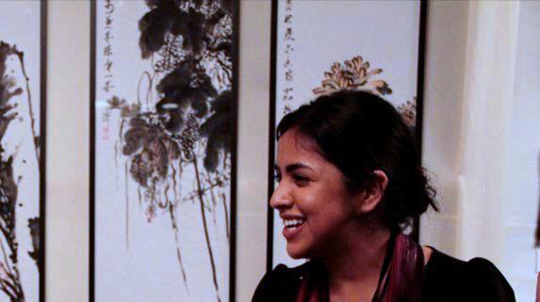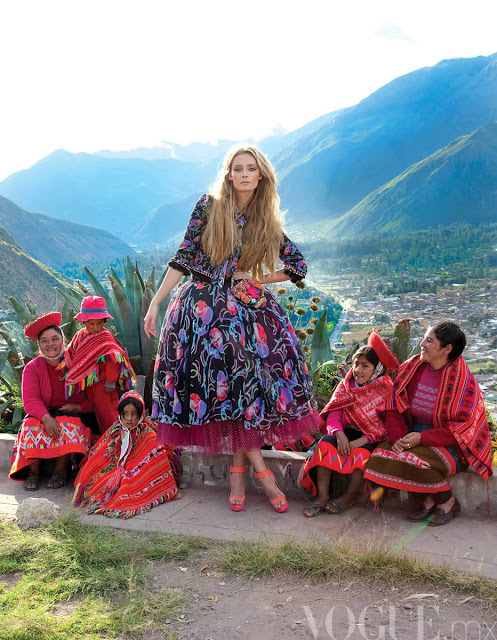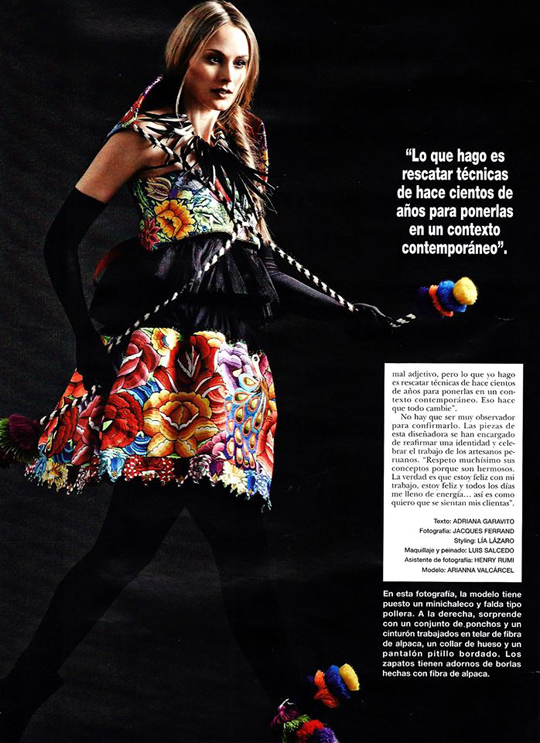 Susana Aguirre is a writer and researcher, most interested in exploring the fashion landscape in her home country of Peru. She holds a BA from The University of Chicago and will graduate from the MA Fashion Studies Program in May 2014. She is currently developing an online database of projects related to fashion design and research in Latin America.
Susana Aguirre is a writer and researcher, most interested in exploring the fashion landscape in her home country of Peru. She holds a BA from The University of Chicago and will graduate from the MA Fashion Studies Program in May 2014. She is currently developing an online database of projects related to fashion design and research in Latin America.
What current project(s) are you at work on or have you just completed?
I recently presented a paper I wrote on the recent and numerous fashion editorials featured in international editions of Vogue shot in Peru, specifically in Cusco (the Andean tourist mecca). I look at the problematics of a recurring visual theme I observe in these images: the models, who are dressed in off-the-runway fashion, stand tall and in the spotlight juxtaposed to local men, women and children who are placed physically below/behind the models, in traditional forms of dress, sitting on the floor and in the shadows. In these images, white bodies in Western fashion are placed in direct contrast with ethnicized bodies in what is seen as non-fashion. I presented the paper at the first annual OLA Graduate Conference on Latin America at The New School. It was fantastic to be a part of this new, interdisciplinary event (there were graduate students from Sociology, Non-Profit Management, Urban Policy, etc.). As an unexpected bonus, the paper (entitled ‘Peru in Vogue: Representations of Ethnicity in Contemporary Fashion Editorials’) was chosen as one of the three prized projects. I was the only Parsons representative this year but I definitely hope more students interested in Latin America will participate in coming years.
I’ve also just completed my thesis entitled ‘Meche Correa: A Case Study on the Construction of a Peruvian Fashion Identity.’ It explores how garments that are widely used in the Andean region of Peru (my native country), are transformed into fashion items by designers. Over the last five to ten years, Peru’s fashion industry has grown rapidly and extensively. Thanks to factors like a stable economy and a growing middle and upper class, there’s no shortage of demand for all things fashion, allowing for Peruvian designers to blossom and international brands to thrive (brands like Zara, Brooks Brothers and Salvatore Ferragamo have entered the market successfully, to give examples). There’s a whole machinery behind the industry now: with fashion bloggers, PR agencies, stylists, photographers, modeling agencies, all working to make the country globally known for its fashion design. Especially through its two major runway events: Lima Fashion Week and Peru Moda. In the process, there has been a concentrated effort by the different players in the industry (with the help of private and public funding) to create and promote a certain kind of unique, Peruvian fashion design identity – one that is rooted in using and reformulating indigenous forms of dress, textiles and weaving techniques.
One such designer who has been lauded for her ability to ‘translate’ indigenous designs into contemporary styles is Meche Correa. I look at how she uses and reformulates Andean themes and designs to create fashionable pieces. Furthermore, I show how different narratives that speak to a (constructed) Peruvian fashion identity place indigenous designs within the sphere of ‘tradition’ and not as fashionable designs in their own right; they are conceptualized as primary/raw material produced by artisans, from which designers can make fashionable clothing. I talk about the historic social and cultural dynamics that have allowed for these conceptual divisions to be drawn up.
What inspired these projects/this project?
I began my career as a writer in Peru just as the industry began to grow much more rapidly four years ago. My first piece was on the nascent business of fashion blogging in Peru, in which young women were capitalizing on the global phenomenon and ultimately became a big part of shaping the local industry. (There is no history of fashion criticism in Peru). I also covered the first edition of Lima Fashion Week, which allowed me to observe the potential of Peruvian-made design and the inner-workings of the business. All this to say that one of my goals in coming to Parsons was to gain the tools with which I could better understand and write about the local fashion developments I was witnessing. The two projects mentioned above stem from my desire to continue to produce critical work about fashion in Peru.
If you’re pursuing more than one project, are you finding connections between these pursuits, or do they feel separate?
In regards to my interests in fashion writing, the ideas of collective identity and socio-cultural design narratives always captivate me. I just completed a paper on Latino-American identity in fashion, in which I looked at four Latino, New York-based brands that transmit personal yet very relatable conceptions of the Latino experience in the U.S. through design.
How have New York’s resources contributed to your current work?
The city is full of resources for people interested in fashion design in general and fashion design in Latin America in particular. From museum exhibits, to conferences, and colleagues from Latin America or interested in the region – there has been no shortage of inspiration for my work while I’ve been in New York.
Is this your first project of this kind? What unique challenges and discoveries are presenting themselves?
The biggest challenge for any fashion writer (who wishes to go beyond academia) is to captivate a large audience with the critical aspects of one’s work. Fashion-centered media in Peru is overwhelmingly positive, leaving little room for critical analyses. I hope to contribute to widening that space in order for more diverse voices and opinions to circulate.
If this project is part of a long-term interest, how have you seen your work shift through time?
In regards to fashion writing: taking a holistic view to what is obviously my predominant interest, fashion in Latin America; to look at what’s happening locally and put it in conversation with larger, global developments and frameworks of the fashion industry.
If you are at the culmination of a project, do you have plans for your next endeavors? What should we look out for from you in the future?
Fellow Peruvian Lucia Cuba (MFA Design and Society ’13) and I met shortly before I came to Parsons. She is marvelous. She has opened my eyes to different fashion design expressions and systems (beyond the very business-oriented manifestations) that exist in Peru. We have worked together on the idea of creating an online database for different projects concerning design research and practice in Latin America. The plan is for the project to see the light of day soon!





























